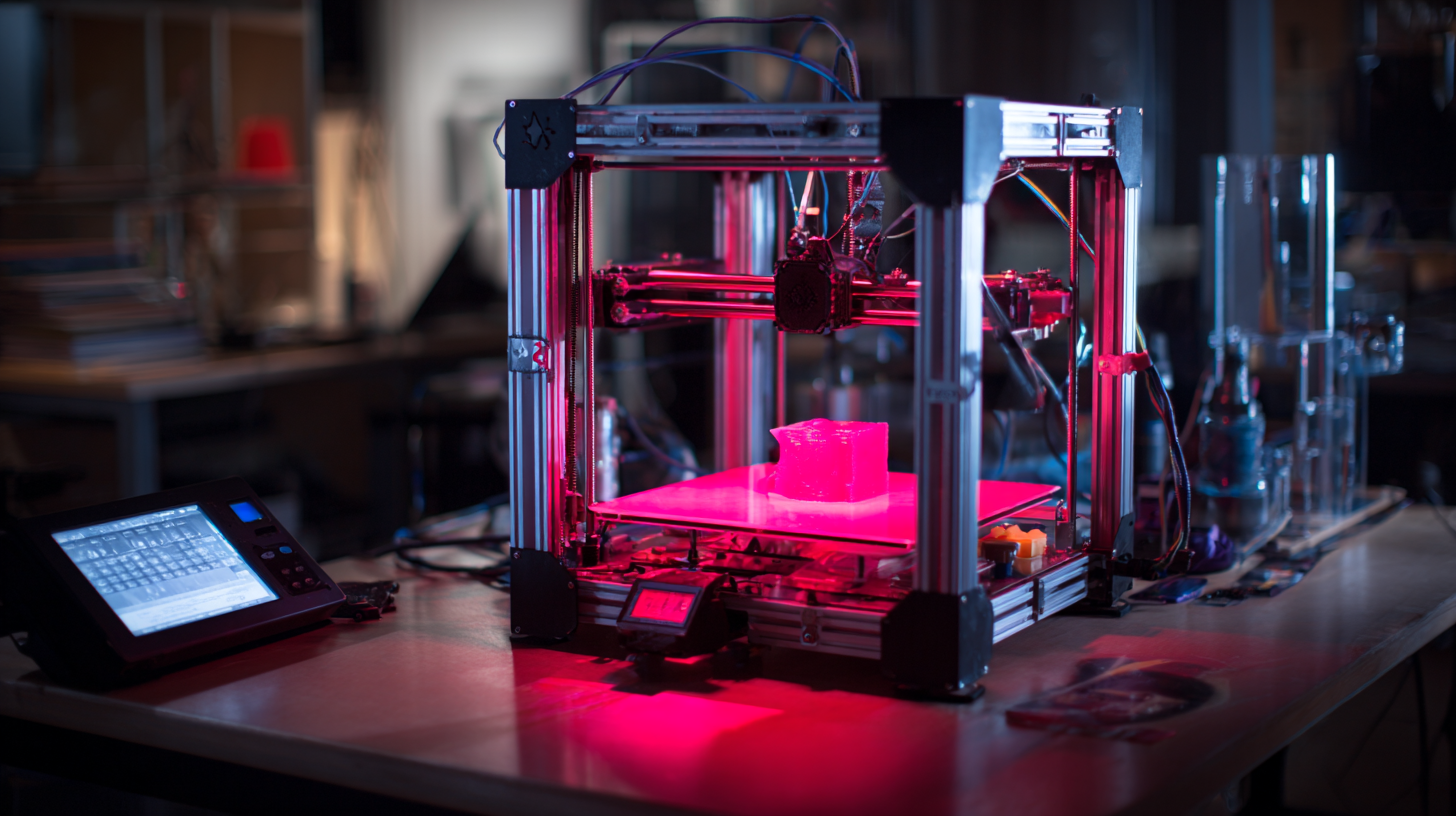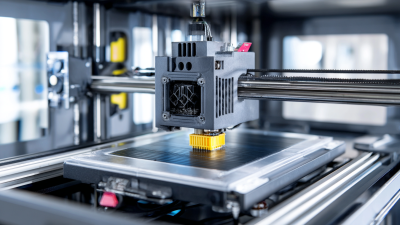Unlocking the Future of Creativity with 3D Printers for Every Home

In recent years, the advent of the 3D printer has revolutionized the way we think about creativity and production in our homes. According to a report by the International Data Corporation, the global market for 3D printing is expected to reach $49 billion by 2025, highlighting a rapid increase in accessibility and usage of 3D printers among consumers. This technology empowers individuals to design and create custom objects, ranging from household items to intricate art pieces, thus fostering an unprecedented level of creativity.
As 3D printers become more affordable and user-friendly, they not only spark innovation but also enable a DIY culture that encourages sustainability through localized production. With the continued integration of 3D printing into everyday life, the potential for transforming homes into creative hubs is immense, making it essential to explore the implications and possibilities that lie ahead.
Table of Contents
[Hide]
Revolutionizing Home Creativity: The Role of 3D Printers
3D printing technology is rapidly evolving, opening new avenues for creativity right in our homes. According to a report by the Wohlers Associates, the 3D printing industry is expected to grow to $35.6 billion by 2024, reflecting a significant shift towards more personal and accessible manufacturing processes. This democratization of technology allows individuals to design and create unique items, from home decor to custom tools, fundamentally altering the landscape of how we think about creativity at home.
The emergence of user-friendly 3D printers has further empowered hobbyists and professionals alike. A 2022 survey by the Consumer Technology Association found that over 20% of households in the U.S. now own a 3D printer, and this number is anticipated to rise as costs decrease and technology improves. This trend not only fosters individual creativity but also promotes innovative problem-solving. For instance, families can create personalized gifts or functional household items, while educators can enhance their teaching methods through hands-on projects. The potential for 3D printers to revolutionize home creativity is just beginning to be realized, paving the way for a future where anyone can be a creator.
Affordable 3D Printing Technologies: Making Innovation Accessible
The rise of affordable 3D printing technologies is revolutionizing the way we approach innovation in our everyday lives. Once limited to industrial use or the realm of savvy entrepreneurs, 3D printing is now gaining traction in homes across the world. This democratization of technology empowers individuals to transform their ideas into tangible objects, fostering a creative spirit unlike any before. With accessible printers and user-friendly software, hobbyists and aspiring inventors alike can experiment, design, and produce custom items ranging from household goods to intricate artistic sculptures.
Moreover, the affordability of these 3D printers significantly lowers the barrier to entry for creative exploration. Families can engage in DIY projects, children can develop their engineering skills, and artists can bring their visions to life without the high costs traditionally associated with manufacturing. As educational institutions also embrace 3D printing in their curricula, a new generation of innovators is emerging, equipped with the skills to navigate and shape our future. This transition not only enhances individual creativity but also strengthens community ties as people share knowledge, collaborate on projects, and inspire one another.
Unlocking the Future of Creativity with 3D Printers for Every Home
| Feature | Description | Price Range (USD) | Ideal User |
|---|---|---|---|
| Print Volume | Max object size that can be printed | $200 - $600 | Hobbyists |
| Printing Technology | FDM, SLA, SLS, etc. | $150 - $3500 | Design Professionals |
| Material Compatibility | Types of materials that can be used | $100 - $800 | Educators and Students |
| Ease of Use | User-friendliness and software support | $200 - $1200 | Beginner Users |
| Print Speed | Time taken to produce a print | $150 - $2000 | Rapid Prototypers |
Empowering DIY Projects: How 3D Printers Enable Personal Expression
In recent years, 3D printing technology has shifted from a niche industrial application to a household staple, empowering individuals to express their creativity through DIY projects. According to a report by Wohlers Associates, the global 3D printing market is projected to reach $34.8 billion by 2024, driven by advancements in desktop printers that cater to hobbyists and small businesses alike. This democratization of technology allows anyone, regardless of technical skill, to turn concepts into tangible creations, from personalized home décor to custom tools.
The versatility of 3D printers fosters unparalleled personal expression, enabling users to design and print unique items that reflect their individuality. Data from the Consumer Technology Association indicates that 25% of American consumers are interested in using 3D printing for personal projects, highlighting a growing trend towards self-sufficiency in production. As 3D printers become more accessible, we can expect to see a surge in creativity, where everyday people are equipped to innovate and share their creations within communities, effectively reshaping the landscape of personal manufacturing.
Unlocking the Future of Creativity with 3D Printers in Homes
This chart illustrates the variety of DIY projects that can be facilitated by 3D printers in a home setting. With diverse applications ranging from home decor to educational models, it showcases how 3D printing enables personal expression and creativity.
From Idea to Reality: The Design Process in Home 3D Printing
The design process in home 3D printing transforms mere concepts into tangible objects, empowering individuals to bring their creative visions to life. It begins with ideation, where users brainstorm and refine their ideas, considering factors such as functionality and aesthetics. This phase is critical, as it lays the foundation for the entire project. Once a solid idea is formed, users transition to sketching or modeling their designs using specialized software. This digital representation allows for experimentation and adjustments, enabling creators to visualize the final product before any material is processed.
After finalizing the design, the next step involves preparing the model for printing. This includes choosing the right materials and adjusting settings for the specific 3D printer in use. Users must understand various printing techniques and technologies to optimize the output according to their needs. Finally, the printing process begins, where the digital model transforms into a physical object layer by layer. This journey from idea to reality not only showcases the ingenuity that 3D printing offers but also opens new avenues for personalization and innovation in everyday life, making it an invaluable tool for modern creators.

Sustainability and Creativity: Eco-Friendly Practices with 3D Printing
The advent of 3D printing technology is revolutionizing the way we think about creativity and sustainability in our homes. According to a report by SmarTech Analysis, the global 3D printing market is projected to reach $35.6 billion by 2024, with a substantial segment driven by innovations in eco-friendly materials. This growing interest in 3D printing offers consumers the ability to create customized items while minimizing waste and reducing carbon footprints. By utilizing biodegradable filaments such as PLA derived from corn starch, hobbyists can engage in creative projects that are both innovative and environmentally responsible.
Moreover, home 3D printing can significantly cut down on excess materials and transportation emissions associated with traditional manufacturing. A study from the Massachusetts Institute of Technology (MIT) found that on-demand 3D printing reduces the need for mass production, which can waste up to 90% of raw materials in some industries. By embracing 3D printing at home, individuals can not only unleash their creativity but also contribute to a more sustainable future by producing only what they need and reimagining existing products into new creations, all while supporting the circular economy.

Related Posts
-

Why Laser Sintering 3D Printers Are Revolutionizing Manufacturing Efficiency by 30%?
-

Challenges Faced by Businesses in Adopting Commercial 3D Printers
-

Top Strategies for Maximizing Efficiency with Sintering 3D Printers
-

What is the Future of 3D Printing Machines in Global Manufacturing
-

How to Optimize Your Workflow with a Professional 3D Printer: Insights from Industry Experts
-

Exploring the Impact of Polymer 3D Printers at the 138th China Import and Export Fair 2025